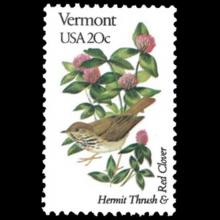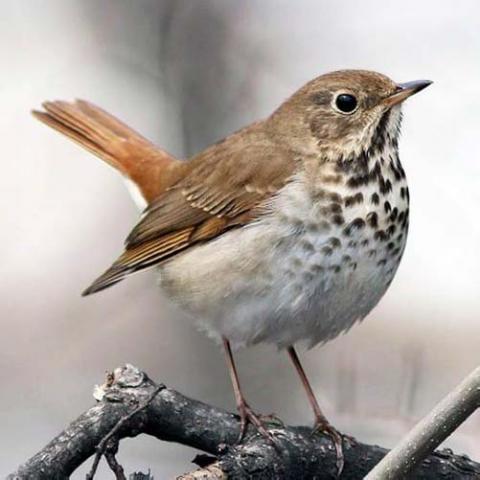NAMES
TAXONOMY
United States
Issued:
Stamp:
Catharus guttatus
United States
Issued:
Stamp:
Catharus guttatus
United States
Issued:
Stamp:
Catharus guttatus
Link (in a new tab) to recordings of: Catharus guttatus (Hermit thrush) at https://xeno-canto.org
Genus species (Animalia): Catharus guttatus
The hermit thrush (Catharus guttatus) is a medium-sized North American thrush. It is not very closely related to the other North American migrant species of Catharus, but rather to the Mexican russet nightingale-thrush. The specific name guttatus is Latin for "spotted."
Description
This species measures 15 to 18 cm (5.9 to 7.1 in) in length, spans 25 to 30 cm (9.8 to 11.8 in) across the wings and weighs 18 to 37 g (0.63 to 1.31 oz). Among standard measurements, the wing chord is 7.8 to 11.1 cm (3.1 to 4.4 in), the bill is 1.6 to 1.9 cm (0.63 to 0.75 in) and the tarsus is 2.7 to 3.3 cm (1.1 to 1.3 in). It is more compact and stockier than other North American Catharus thrushes, with relatively longer wings. The hermit thrush has the white-dark-white underwing pattern characteristic of Catharus thrushes. Adults are mainly brown on the upperparts, with reddish tails. The underparts are white with dark spots on the breast and grey or brownish flanks. They have pink legs and a white eye ring. Birds in the east are more olive-brown on the upperparts; western birds are more grey-brown.
Behavior
Hermit thrushes breed in coniferous or mixed woods across Canada, southern Alaska, and the northeastern and western United States. They make a cup nest on the ground or relatively low in a tree.
While most hermit thrushes migrate to wintering grounds in the southern United States and south to Central America, some remain in northern coastal US states and southern Ontario. They usually breed in forests, but will sometimes winter in parks and wooded suburban neighborhoods. They are very rare vagrants to western Europe and northeast Asia.
They forage on the forest floor, also in trees or shrubs, mainly eating insects and berries.
Song
The hermit thrush's song has been described as "the finest sound in nature" and is ethereal and flute-like, consisting of a beginning note, then several descending musical phrases in a minor key, repeated at different pitches. It often sings from a high open location. Analysis of the notes of its song indicates that they are related by harmonic simple integer pitch ratios, like many kinds of human music and unlike the songs of other birds that have been similarly examined.
Reference: Wikipedia, U.S. Fish and Wildlife Service
Photo: allaboutbirds.org
Sounds: allaboutbirds.org



